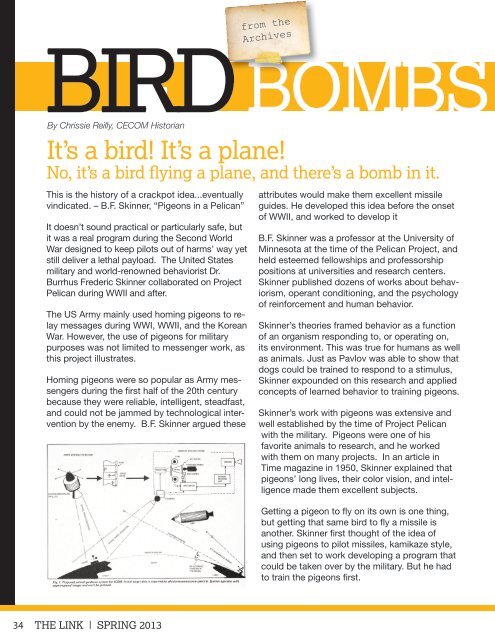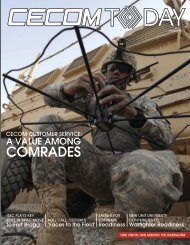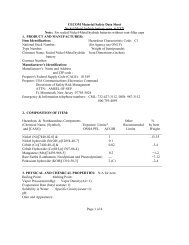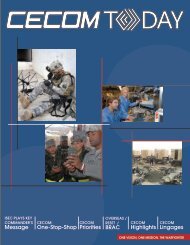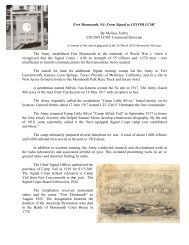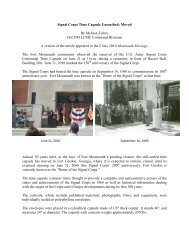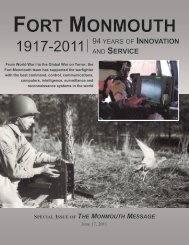download PDF version - CECOM - U.S. Army
download PDF version - CECOM - U.S. Army
download PDF version - CECOM - U.S. Army
You also want an ePaper? Increase the reach of your titles
YUMPU automatically turns print PDFs into web optimized ePapers that Google loves.
from the<br />
Archives<br />
BIRD BOMBS<br />
By Chrissie Reilly, <strong>CECOM</strong> Historian<br />
It’s a bird! It’s a plane!<br />
No, it’s a bird flying a plane, and there’s a bomb in it.<br />
This is the history of a crackpot idea...eventually<br />
vindicated. – B.F. Skinner, “Pigeons in a Pelican”<br />
It doesn’t sound practical or particularly safe, but<br />
it was a real program during the Second World<br />
War designed to keep pilots out of harms’ way yet<br />
still deliver a lethal payload. The United States<br />
military and world-renowned behaviorist Dr.<br />
Burrhus Frederic Skinner collaborated on Project<br />
Pelican during WWII and after.<br />
The US <strong>Army</strong> mainly used homing pigeons to relay<br />
messages during WWI, WWII, and the Korean<br />
War. However, the use of pigeons for military<br />
purposes was not limited to messenger work, as<br />
this project illustrates.<br />
Homing pigeons were so popular as <strong>Army</strong> messengers<br />
during the first half of the 20th century<br />
because they were reliable, intelligent, steadfast,<br />
and could not be jammed by technological intervention<br />
by the enemy. B.F. Skinner argued these<br />
attributes would make them excellent missile<br />
guides. He developed this idea before the onset<br />
of WWII, and worked to develop it<br />
B.F. Skinner was a professor at the University of<br />
Minnesota at the time of the Pelican Project, and<br />
held esteemed fellowships and professorship<br />
positions at universities and research centers.<br />
Skinner published dozens of works about behaviorism,<br />
operant conditioning, and the psychology<br />
of reinforcement and human behavior.<br />
Skinner’s theories framed behavior as a function<br />
of an organism responding to, or operating on,<br />
its environment. This was true for humans as well<br />
as animals. Just as Pavlov was able to show that<br />
dogs could be trained to respond to a stimulus,<br />
Skinner expounded on this research and applied<br />
concepts of learned behavior to training pigeons.<br />
Skinner’s work with pigeons was extensive and<br />
well established by the time of Project Pelican<br />
with the military. Pigeons were one of his<br />
favorite animals to research, and he worked<br />
with them on many projects. In an article in<br />
Time magazine in 1950, Skinner explained that<br />
pigeons’ long lives, their color vision, and intelligence<br />
made them excellent subjects.<br />
Getting a pigeon to fly on its own is one thing,<br />
but getting that same bird to fly a missile is<br />
another. Skinner first thought of the idea of<br />
using pigeons to pilot missiles, kamikaze style,<br />
and then set to work developing a program that by xxx<br />
could be taken over by the military. But he had<br />
to train the pigeons first.<br />
34 THE LINK | SPRING 2013


